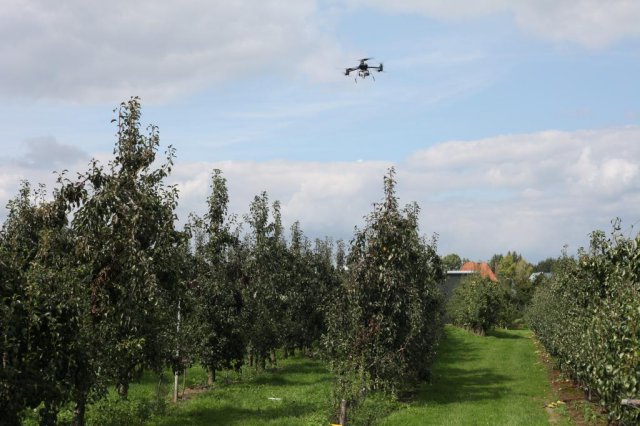This rapid spread of the disease makes early detection essential. There are already warning systems, but Vito and the Fruit Test Centre are developing a new detection system that would use UAS to track potential outbreaks of fire blight.
Stephanie Delalieux of Vito is one of the people behind the project. “UAS give us the opportunity to monitor much larger areas than the current field tests,” she says. “In time, this system would be able to cover an entire province.”
Right now, she continues “everything is still in the development phase, but eventually we want to offer farmers and growers a pool of data where they can see if blight has been detected nearby. This will allow them to intervene at a very early stage.”
A disaster for farmers
The leaves on trees that are affected by fire blight shrivel and darken, but in the beginning, only a few leaves on the top branches change colour. How can a UAS detect these small sources of infection between the endless rows of fruit trees?
The UAS provide extremely detailed images, down to one centimetre
“The UAS provide extremely detailed images; we can focus down to just one centimetre,” explains Stephanie Delalieux. “Currently we are working on a way to sort out all that information. It’s not an easy task, to say the least. A black twig against a black surface is barely noticeable. That’s why we are developing hyperspectral sensors that show us more than just a visible image and use a mathematical algorithm to facilitate the searching.”
An outbreak of fire blight is a disaster for farmers; a fruit farmer forced to destroy an entire orchard of trees can lose several years of income. The disease primarily affects pear and apple trees, but also many wild and garden plants.
And there’s also an export risk. “The fruit region of Haspengouw in Limburg is looking at China as a potential market for pears,” says Delalieux. “In China, fire blight doesn’t exist, and they want to keep it that way. If we want to export pears, we need to guarantee they are free from any contamination. With this project, we will be able to define large safe zones.”
Are there already UAS flying around Flanders’ fruit trees? Not yet, says Delalieux. “At the moment, we are working on experiments inside greenhouses, performing tests with trees we have infected ourselves. In the next phase, the drones will fly out over plantations where we know there are pockets of infection. Once our drones are operational, there will be a follow-up project to make the data that our drones have detected accessible to fruit farmers. Apart from the technical issues, we also need permission from several government agencies. You can’t just go out and release your UAS into the sky.”
Source: Flanders Today

